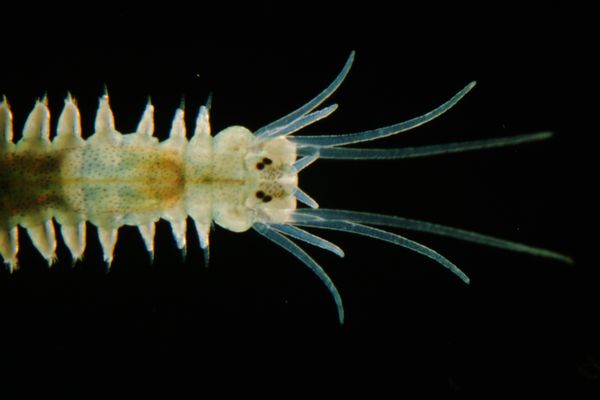Marine Animals Keep Time With Multiple Clocks
The head and front torso of a marine worm, Platynereis dumerilii.
From fungi to farm animals to humans, organisms across a broad spectrum experience daily cycles controlled by a circadian clock. This internal clock tells us when to sleep or rest, and when it's time to wake up.
But it turns out that some animals—and perhaps even humans—keep time with more than one kind of clock, new studies say.
Many marine animals are intimately connected to cycles that don't run on a 24-hour schedule. Tidal cycles can affect foraging or activity patterns multiple times a day, whereas monthly cycles can control reproduction every 30 days or so.
Fishers in civilizations as far back as ancient Greece noticed that the size and weight of certain mussels and urchins followed the lunar cycle, said Kristin Tessmar-Raible, a molecular neurobiologist at the University of Vienna in Austria.
"These fishermen were observing the gonads, which get bigger or smaller according to the lunar cycle," she explained.
Scientists in the 20th century also observed such cycles in a wide variety of marine organisms, from the mass spawning events of coral reefs and worms to the twice-daily foraging patterns of coastal crustaceans.
But with only behavioral studies, it was difficult to figure out whether several internal clocks controlled such cycles independently, or if those clocks were modified from a single clock.
"That's where we picked up the story," said Tessmar-Raible, co-author of a study published September 26 in the journal Cell Reports.
Both Tessmar-Raible's group and a separate group including behavioral geneticist Charalambos Kyriacou of the University of Leicester in England found molecular evidence in two separate marine animals that they harbored more than one clock.
A Lunar Mystery
Tessmar-Raible’s team discovered evidence of an independent circalunar clock—a timer linked to the phases of the moon—in a marine worm called a ragworm (Platynereis dumerilii).
This ragworm mates during the dark of a new moon, and its populations time their sexual maturity to that time of the month.
By looking at the ragworm’s maturation cycle, and disrupting the expression of daily clock genes in the heads of immature ragworms, researchers were able to demonstrate that the circalunar clock and the circadian clock are two separate entities.
But in an intriguing twist, it turns out that the circalunar clock can influence the genes involved in the ragworm's circadian clock, as well as affect the worm's daily travel activities—the worms often crawl around on seaweed or rocks.
Tessmar-Raible isn't sure how that's happening, since the molecular workings behind the circalunar clock are still a mystery.
Two Timers
Kyriacou and his team also found evidence of two clocks in a marine crustacean called Eurydice pulchra—a marine relative of the common terrestrial pill bug. But in this case, the additional clock was a tidal clock rather than a lunar one.
The circatidal clock also ran independently of the crustacean's circadian clock.
E. pulchra forages with the tides, actively swimming when it comes in and then burrowing into the sand when the tide goes out, explained Kyriacou, co-author of a study published September 26 in the journal Current Biology.
It was clear E. pulchra was on a tidal schedule—or running on a circatidal clock—but how that clock worked was up for debate, he said.
Some researchers thought that the circatidal clock was just two circadian clocks running out of phase with each other, Kyriacou said. Others thought that the circatidal and circadian clocks were two independent timers.
"And that's where the work stood for many years," he added.
Kyriacou and colleagues demonstrated that E. pulchra had two independent clocks by disrupting the proteins involved in the circadian clock and seeing how that affected swimming activity controlled by the crustacean's circatidal clock.
"It looks like they're their own systems," said Kyriacou. "They might use some of the same molecules, but the circadian clock as an entity is not driving the tidal clock."
Unlike the clocks Tessmar-Raible found, the clocks in E. pulchra don't seem to talk to each other.
"I was a bit surprised that it turned out the way it did," said Kyriacou. "I thought there would be a tighter connection between them."
He even had a bet going with one of his co-authors, Michael Hastings of the MRC Laboratory of Molecular Biology in Cambridge, England. "So I lost the bet," Kyriacou said with a laugh.
A Clock's Innards
Both Kyriacou and Tessmar-Raible plan to dig deeper into the molecular and genetic underpinnings of their respective clocks.
In a bid to determine whether one clock-related gene functions in both circatidal and circadian clocks in the marine crustacean E. pulchra, Kyriacou plans some genetic experimentation.
"We're knocking out some of the other clock genes to see if some of them are reused," he said.
The same or similar clock genes show up in many different species, said Kyriacou. So this kind of research definitely has broader implications for other creatures in addition to coastal crustaceans.
Tessmar-Raible adds that multiple clocks could very well exist in terrestrial animals and in humans. "Some genes in [the] mouse oscillate with a period of about 12 hours, which is the period of the circatidal clock," she said.
A recent study indicates that human sleep is influenced by the lunar cycle, while another study suggests certain hormones in men cycle on a monthly or semi-monthly basis.
Why would mouse genes cycle every 12 hours? Why would humans need monthly timers? These are intriguing questions that certainly merit a closer look, Tessmar-Raible said.
Jane J. Lee
National Geographic
Published September 26, 2013












